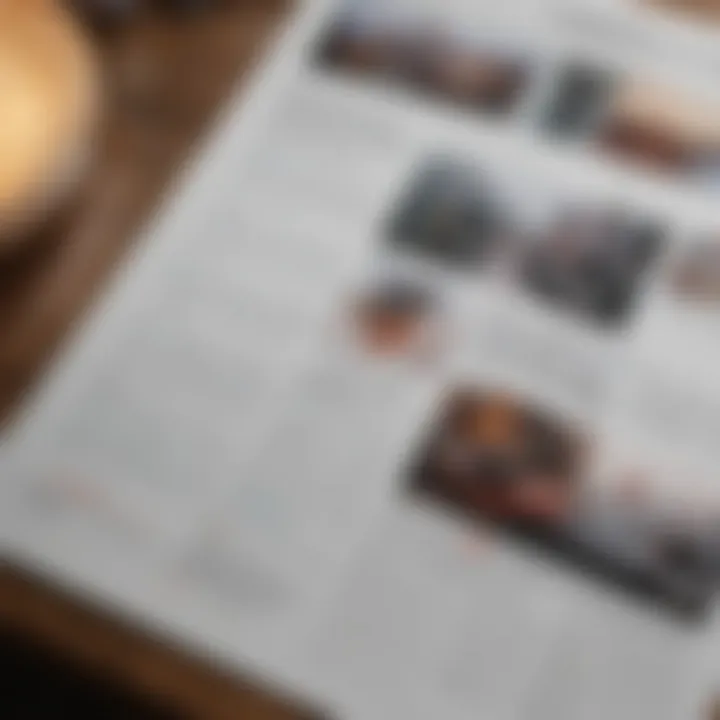Crafting Effective Newsletter Emails: The Ultimate Guide


Intro
In the digital realm of marketing, newsletters have emerged as a key player in fostering communication between businesses and their audiences. Whether a startup or a seasoned enterprise, the importance of a well-crafted newsletter cannot be stressed enough. This guide aims to dissect the essential elements that contribute to an effective newsletter email, shaping how each aspect resonates with those receiving it.
Understanding your audience is the first puzzle piece in crafting an impactful newsletter. You can't throw spaghetti against the wall to see what sticks. Knowing their interests, pain points, and preferences allows you to curate content that not only attracts their attention but also encourages engagement.
With the constant ebb and flow of technology and trends, keeping newsletters fresh and relevant is crucial. As businesses evolve, so too must their communication strategies. This guide will delve into the nuances of effective writing techniques, smart design choices, and the metrics that matter when assessing your newsletter’s performance. Each section is designed to empower entrepreneurs, marketers, and CRM specialists to create communications that echo with their target market.
So, whether you're embarking on a newsletter journey for the first time or looking for ways to optimize your existing strategy, buckle up. The insights shared in this guide are tailored to equip you with the knowledge to make your newsletter more than just a footnote in your readers' inboxes but a valuable resource they anticipate eagerly.
Prolusion to Newsletter Emails
Newsletter emails have become an integral part of the fabric of modern business strategies. They serve not just as communication tools but as vital touchpoints between a brand and its audience. At their core, these emails are crafted with the intention of conveying information, promoting engagement, and reinforcing brand identity. While the digital landscape continues to evolve, the essence of a well-structured newsletter remains steadfast—conveying messages clearly, maintaining a consistent tone, and driving actionable results.
The importance of newsletter emails in this article lies in their multifaceted role. From small startups to larger enterprises, newsletters allow organizations to share updates, insights, or special offers while nurturing relationships with their clientele. In essence, they function like a friendly nudge to inform, educate, and inspire the reader, thereby building trust and loyalty.
Defining Newsletter Emails
A newsletter email is typically a periodic communication sent to a subscribed audience, packed with information relevant to the subscribers’ interests or needs. It can range from company updates, product promotions, industry news, to curated content that aligns with the reader's preferences. In contrast to regular promotional emails, newsletters are often less sales-oriented and more focused on providing value.
The structure of newsletter emails can widely vary but usually includes a catchy subject line, an engaging header, and well-organized content that encourages readers to delve deeper. A hallmark of a good newsletter is not just what is shared but how it resonates with the audience. Therefore, defining a newsletter goes beyond mere aspects—it's about understanding the audience it serves, the intent behind its creation, and the style in which the information is conveyed.
Importance in Modern Business Communication
Emphasizing the significance of newsletter emails in contemporary business communication reveals several key benefits:
- Builds Relationships: Regular communication through newsletters fosters a sense of connection. Recipients begin to expect and look forward to these emails, paving the way for stronger relationships.
- Brand Awareness: Consistently sending newsletters keeps your brand top-of-mind. This is crucial in today’s fast-paced digital world, where numerous brands vie for consumer attention.
- Drives Traffic: Properly crafted newsletters can direct readers to your website, blog, or social media pages, enhancing overall engagement.
- Educates Your Audience: They are excellent avenues for educating your audience about new products, services, or industry trends, establishing you as a thought leader in your domain.
A strong newsletter can ultimately contribute significantly to achieving business objectives, whether it's increasing sales, expanding customer loyalty, or solidifying your company’s position in the market.
"In a world swamped with fleeting messages, a well-crafted newsletter stands out as a beacon of consistent and valued communication."
As we embark on the journey to crafting the perfect newsletter email, it's essential to keep these considerations in mind. Understanding not only what a newsletter is but its importance in today's bustling business landscape will lay a crucial foundation for the succeeding sections.
Understanding Your Audience
When it comes to crafting a newsletter email that truly connects, understanding your audience is like hitting the nail on the head. Grasping the nuances of who you're speaking to can make or break your efforts. Not only does it allow you to tailor your message, but it also builds a relationship grounded in trust and relevance. This section dives into key components of recognizing your audience's makeup and how segmenting them can yield more impactful communications.
Identifying Target Demographics
To kick things off, identifying your target demographics might seem straightforward, yet it's fundamental. It’s the backbone of any successful newsletter. Think about it: if you're selling art supplies, your audience isn't just anyone with an email address. It's more likely to be artists, students, educators, or perhaps even hobbyists looking to rekindle their creative flame.
Here are some factors to consider:
- Age: Different generations consume content differently. Tailoring the tone and style according to age ranges boosts engagement.
- Location: Consider where your audience is based. Geographical preferences can influence your content significantly. For instance, climate can dictate what products are relevant at certain times of the year.
- Profession: What does your audience do? Knowing their industry can help tailor your messaging for certain professional challenges.
- Interests: Understanding what interests them can inform not just your content, but also how to present it.
By gathering this data, you can build a comprehensive picture of who your readers are, ensuring that each issue resonates at a deeper level.
Segmenting Your Audience
Once you've nailed down the demographics, it's time to break things down further. Segmentation allows you to tailor your message for different audience groups more precisely.
Here’s where it can get interesting:
- Behavioral Segmentation: This involves grouping people based on their interactions with previous newsletters. If some subscribers consistently click on product links while others primarily engage with articles, they might appreciate different types of content.
- Psychographic Segmentation: Think about values, attitudes, and lifestyles. This approach digs beneath surface-level stats to discover what makes your audience tick. For example, environmentally conscious audiences will appreciate sustainable product highlights, while a more luxury-focused demographic might respond better to premium offerings.
- Engagement Level: Differentiate based on how actively users engage with your emails. New subscribers might need a mix of introductory content, while long-term subscribers could appreciate more exclusive deals or advanced insights.
"The beauty of segmenting your audience is that it stops you from casting a net too wide, ensuring that your message lands where it can have the most impact."
In summary, the effort you put into understanding and segmenting your audience translates to more effective newsletter communications. By diving deep into who your readers are and what they want, you ensure that each email feels personal and relevant, ultimately enhancing engagement and loyalty.
Crafting Clear and Compelling Content
In the fast-paced digital world, where information is always at our fingertips, creating clear and compelling content for your newsletter email is not just beneficial; it's essential. A well-crafted newsletter doesn't merely relay information; it captures attention, engages the reader, and fosters a connection between your brand and your audience. Below, we examine what makes content effective and how it can drive engagement.
Key Elements of Effective Writing
When setting out to compose content that resonates, several foundational elements should guide your approach. First and foremost is clarity. Aim to express your ideas in a straightforward manner. Avoid jargon that may confuse or alienate your audience.
- Conciseness: This entails not only brevity but also relevance. Every sentence should have a clear purpose, focusing on the reader's needs, interests, and potential actions. Instead of trailing down a lengthy explanation, cutting to the chase can hold the reader’s interest better.
- Engaging Language: Use words that elicit responses. Instead of telling your audience "this product can help you," consider phrasing it as, "Imagine freeing up your time with our solution." This invites visualization and makes the communication feel more personal.
- Strong Opening Lines: The first few lines are crucial; they must hook the reader. A captivating question or a surprising fact can encourage readers to delve deeper.
Achieving Consistency in Tone and Messaging


Staying consistent in your tone is vital for reinforcing your brand's identity. Whether your newsletter aims for a professional demeanor or a more casual banter, keep it uniform across all communications. Here’s how:
- Define Your Voice: Think about how you want to be perceived. Do you want to come off as an expert, a friendly guide, or maybe a thought leader? This decision will inform your language, style, and overall tone.
- Use a Style Guide: Having a documented guide that outlines your preferred vocabulary, sentence structure, and even formatting can ensure that every piece fits neatly into your brand’s narrative.
- Adapt for Audience Segments: While maintaining a general tone, you could tailor language styles to different segments of your audience without straying from your brand's core message. For instance, a newsletter directed at technical professionals might involve more industry-specific terminology than one aimed at a general audience.
Incorporating Calls-to-Action
A call-to-action (CTA) is not just a marketing trick; it's the bridge that links your content to the desired outcome. It should be clear, compelling, and direct. Think of these elements:
- Purposeful Placement: Your CTAs should be strategically placed within the content. A good spot might be right after introducing a new feature or after a customer testimonial, where interest peaks.
- Action-Oriented Language: Use verbs that convey urgency or curiosity. Instead of saying "Learn more," try "Discover how you can optimize your workflow today!"
- Limit Options: Too many options can be overwhelming. Stick to one or two primary actions you want readers to take. This keeps your newsletter focused and easy to follow.
A dedicated focus on effective writing in newsletter emails not only shapes how your audience perceives your brand but also drives tangible engagement outcomes.
By focusing on crafting clear and compelling content that captures attention and fosters engagement, you lay the groundwork for a meaningful connection with your audience, ultimately propelling your business goals.
Newsletter Structure
Creating an effective newsletter requires more than just quality content; a well-thought-out structure is key. The structure of a newsletter encompasses how information is presented, guiding the reader's experience from the moment they open the email. This can directly influence engagement levels, retention of information, and the likelihood of readers taking desired actions. Each element plays a distinct role, contributing to the overall effectiveness of the communication. Understanding how to structure a newsletter is essential for sales professionals, entrepreneurs, and startup founders who aim to convey clarity and professionalism while fostering connection with their audience.
Subject Line Best Practices
The subject line is arguably the first and often the most crucial element of your newsletter. It serves as the gatekeeper to your content, determining whether an email gets opened or sits unopened in a crowded inbox. A strong subject line can significantly increase open rates, leading to better engagement.
Here are some practices to keep in mind:
- Be Clear and Concise: Aim for around 6-10 words that clearly convey the essence of the newsletter.
- Create Urgency: Phrases like "limited time" or "don’t miss out" can compel readers to take action quickly.
- Personalization: Including the recipient's name can enhance engagement, as it makes the email feel tailored to them.
- Avoid Spammy Words: Terms like "free" or "guaranteed" can send your email straight to the spam folder.
"A well-crafted subject line is the first step toward successful email marketing."
Header and Prologue
The header and introduction set the tone for your newsletter email. This is where you capture attention and give your readers a taste of what information lies ahead. The header should reinforce your branding while being visually appealing to draw attention.
In the introduction, aim for:
- A Brief Overview: Summarize the main themes or updates succinctly.
- Inclusivity: Use phrases like "in this edition, we explore" to keep the reader engaged.
- Value Proposition: Clearly state what benefit the reader will gain from reading on.
Main Content Areas
The main content areas are where the bulk of your information resides. Structuring this section with clarity can work wonders in keeping your audience engaged. Consider using headings or bullet points to break the text down into digestible pieces. This makes it easier to skim, which is often how people read newsletters.
Key aspects to consider include:
- Subheadings: These help organize content and guide the reader through different sections, enhancing their ability to find information quickly.
- Visuals: Incorporating images, infographics, or videos can break the monotony of text and add a visual appeal to your narrative.
- Variety in Formats: Mixing text with lists or tables can cater to different reading preferences, ensuring information is accessible to all.
Ending and Sign-off
The conclusion of your newsletter should not be an afterthought. It’s the final opportunity to reinforce the message and prompt action. End your newsletter with a strong summary that reiterates key points. Additionally, a thoughtful sign-off can leave a lasting impression.
Consider:
- Recap Main Points: A brief summary can help readers recall what they just learned.
- Call-to-Action: Whether it’s to sign up for an event, visit your website, or follow your social media, a clear CTA can help direct their next steps.
- Personal Touch: A friendly sign-off with gratitude can enhance the reader's connection, making them feel valued. But avoid sounding overly casual; keep it professional.
By using a well-defined structure, you not only create a more inviting experience for your readers but also ensure that your message is clearly communicated, resulting in better engagement and more effective communication overall.
Design Considerations
When it comes to newsletter emails, design is often the unsung hero that significantly impacts engagement and effectiveness. Strong design considerations not only catch the reader's eye but also guide them through the content smoothly. It's about crafting an experience that feels cohesive and compelling, while also ensuring that your brand stands out in a crowded inbox. Each element of design plays a vital role in communicating your message, retaining attention, and prompting action.
Visual Hierarchy and Layout
Visual hierarchy is key to ensuring that your content is digestible and engaging. By organizing your content in a way that prioritizes what’s most important, you can guide the reader through the material effectively. Begin with the main subject line or image, which should pop out right at the top, drawing attention immediately.
Consider this simple tip: use larger font sizes for headlines and smaller for supporting text to create a clear distinction between different sections. Employing ample white space allows readers to focus without feeling overwhelmed. The layout should not just be aesthetic; it should reflect the flow of information. This means structuring sections that logically lead from one to the next.
Important elements to incorporate include:
- Clear headings that define each segment of your newsletter
- Bullet points for easy news bites
- Visual breaks to prevent information overload
For instance, if you’re sharing updates on services, you might present each service as an individual section with a brief title, an engaging image, and a short description to keep the reader’s attention.
Typography Choices
Choosing the right typography sets the tone and helps convey your message effectively without overwhelming your readers.Sans-serif fonts like Arial or Helvetica are often favored for digital communication, offering a clean and modern look. However, don't shy away from adding personality with well-chosen typefaces that align with your brand's voice.


One vital principle is to maintain consistency. Using a single typeface throughout ensures a neat appearance. It’s generally best to reserve more decorative fonts for headings or special sections and stick to something simpler for body text. Be mindful of line spacing too; cramped text can be a quick ticket to reader fatigue.
Here’s a quick outline for typography usage:
- Headlines: 24-32pt
- Sub-headlines: 18-24pt
- Body Text: 12-14pt
In essence, the right typography enhances readability while also allowing your brand personality to shine through without overshadowing the core message.
Color Schemes and Branding
Color schemes are more than just decoration; they’re the very essence of your brand’s identity. Every shade you choose whispers something about your business. For instance, blue could exude trust and dependability, while yellow might evoke warmth and friendliness. Hence, it’s crucial to select a palette that aligns with your brand messaging and audience preferences.
Utilizing colors effectively can guide readers' emotions and reactions. A limited color palette usually works best; two to three primary colors complemented by neutral shades keeps things visually appealing without overwhelming readers. Use your brand colors to highlight headings, buttons, and links. This not only reinforces your branding but also makes it easy for readers to identify actionable items.
Remember, a well-designed newsletter isn’t just about looking good; it’s about creating a seamless experience that keeps your audience coming back for more.
Your thoughtful approach to design can transform a standard email into a visual treat that resonates with readers and reinforces your brand's personality.
Technical Aspects of Sending Emails
When it comes to crafting a successful newsletter email, the technical side cannot be overlooked. This aspect forms the backbone of how your messages are delivered, received, and interacted with. Ignoring the technical details can lead to your well-crafted content getting lost in the void. Understanding the complexities involved in sending emails will help you ensure that your communication reaches the intended audience effectively.
Choosing the Right Email Service Provider
Selecting an appropriate email service provider (ESP) is one of the most critical decisions you will make in your email marketing journey. The right ESP not only supports your newsletter's design but also enhances its deliverability. Look for features that cater specifically to your needs:
- User-Friendly Interface: A simple, intuitive dashboard can make or break your efficiency.
- Automation Tools: Features such as automatic segmentation and personalized messaging can save you precious time and increase engagement.
- Analytics and Reporting: Robust reporting tools allow you to measure performance easily, giving you insights on open rates, click rates, and subscriber behavior.
When evaluating providers, consider scalability too. If your business is poised for growth, you'll want an ESP that can grow alongside it. Examples like Mailchimp, ConvertKit, and SendinBlue are popular but always check for user reviews and specific features that might align with your specific case.
Compliance with Email Regulations
Adhering to electronic communication laws is not just a best practice; it’s a necessity. Failing to comply can lead to hefty fines and damages to your brand reputation. A few key regulations to be aware of include:
- General Data Protection Regulation (GDPR): If you’re targeting European customers, understand their rights regarding data privacy and ensure you have permission to send emails.
- CAN-SPAM Act: In the United States, make sure that your emails have clear opt-out options and truthful subject lines. You can’t just hit ‘send’ and hope for the best.
- CASL (Canadian Anti-Spam Legislation): Should your audience include Canadians, you must acquire express consent before sending out any marketing emails.
In summary, being on the right side of compliance not only protects you legally but also fosters trust with your audience. Taking these regulations into account while crafting your newsletter ensures that you are reaching your audience without facing unintended consequences.
"A smooth sea never made a skilled sailor." Navigating technical aspects may feel overwhelming, but mastering them is key to achieving email marketing success.
Measuring Success
In the ever-evolving landscape of digital marketing, determining the effectiveness of your newsletter emails is crucial. This means looking beyond simply hitting send. Measuring success involves identifying how well your email communicates its message, engages the audience, and ultimately drives desired actions. It's more than just curiosity—it's about making informed decisions that enhance your strategies and optimize your resources.
Understanding the metrics associated with newsletter performance provides insight into what resonates with your audience. You want to know what works, what doesn’t, and how to improve next time. This section will delve into the pivotal elements of success measurement, emphasizing the benefits of tracking key performance indicators (KPIs) and analyzing engagement rates.
Key Performance Indicators to Track
When it comes to measuring the success of your newsletter, Key Performance Indicators (KPIs) serve as a compass guiding your strategy. Here are essential KPIs to keep an eye on:
- Open Rate: This metric shows the percentage of subscribers who opened your email, hinting at the effectiveness of your subject lines.
- Click-Through Rate (CTR): This reflects the percentage of readers who clicked on links within the email, indicating content engagement.
- Conversion Rate: Perhaps the most impactful, this tracks how many readers took the desired action, such as making a purchase or signing up for an event.
- Bounce Rate: This identifies the percentage of delivered emails that could not be delivered, informing your list health.
- Unsubscribe Rate: This metrics tells you how many recipients opted-out after receiving your newsletter, useful for gauging content relevance and satisfaction.
Staying on top of these KPIs allows you to adjust your approach. If your open rate is lower than expected, it may be time to rethink your subject lines. If your click-through rate is stagnating, there may be promise in refining your calls-to-action.
Analyzing Open and Click Rates
Evaluating open and click rates gives invaluable insights into audience behavior. Understanding these figures can be similar to reading the tea leaves of your audience’s preferences. Here’s how to effectively scrutinize these rates:
- Open Rates:
- Click Rates:
- Benchmarking: Compare against industry standards to see how you stack up. For example, typical open rates hover around 20-30% for many sectors.
- Patterns and Trends: Look for patterns related to send times and days. Experimentation could lead to discovering the sweet spot when your audience is most receptive.
- Link Breakdown: Analyze which links garner the most clicks. This helps in understanding content that grabs attention.
- Call-to-Action Placement: Assess where your CTAs are placed. Is it within the first screen read? Sometimes, moving a button can generate better results.
"Success is not the key to happiness. Happiness is the key to success. If you love what you are doing, you will be successful."
Additionally, consider A/B testing different subject lines or design formats. This process not only keeps the content fresh but also provides tangible data to guide future efforts, ensuring that each newsletter sent has a greater chance of success than its predecessor.
By synthesizing information from your KPIs, you can cultivate a culture of continuous improvement—effectively tuning your messaging until it strikes just the right chord with your audience.
Continuous Improvement
In the realm of newsletter emails, the concept of continuous improvement holds great significance. This approach is all about refining your strategies, enhancing your content, and making your communication as impactful as possible. The nature of email marketing requires adaptability; what works today may not resonate tomorrow. Therefore, instilling a mindset of ongoing refinement is not merely beneficial—it's essential.


Testing Different Strategies
Dabbling with various strategies can lead to significant breakthroughs. It’s akin to cooking; sometimes the secret ingredient isn't obvious until you try a few things. Start by experimenting with different formats—send out plain text newsletters one week, and HTML ones the next. Change the tone; from casual to professional or vice-versa. Engage in A/B testing for subject lines to see what catches your audience's attention better.
Here are a few strategies you might consider:
- Frequency Variations: Adjust how often you send your emails. This could mean weekly, bi-weekly, or even monthly, depending on your audience's preferences.
- Content Diversification: Mix up the types of content in your newsletter. Feature articles, interviews, or customer stories can add variety.
- Calls-to-Action (CTAs): Try different CTAs to see what encourages more engagement.
A/B testing provides quantitative feedback that can guide your choices moving forward, ensuring that your newsletters evolve in alignment with audience expectations.
Iterating Based on Feedback
Feedback, when taken seriously, can be a goldmine for improvement. Once you've implemented changes, pay careful attention to the data collected. Analyze the responses—open rates, click-throughs, and any direct feedback from your audience. Gathering insights can paint a clearer picture of what's resonating and what’s falling flat.
- Audience Surveys: Consider sending out an occasional survey. Ask your readers directly what they like or dislike about the newsletters. This information can offer nuanced insights.
- Social Listening: Monitor your social media comments. Your audience might express their opinions about your content and design, which could inform future decisions.
- Performance Metrics: Regularly check your email analytics. Trends over time can reveal patterns that warrant course adjustments.
"Continuous improvement is better than delayed perfection."
By iterating based on real feedback, rather than assumptions, you ensure your newsletters stay relevant and effective. The conversation between you and your audience can engender trust and loyalty, ultimately leading to sustained engagement.
With the appropriate adjustments and strategies, the journey of continuous improvement will help you move closer to mastering the art of newsletter emails.
Real-World Sample Email
In the realm of email marketing, the concept of a real-world sample email plays a pivotal role. This serves as a tangible representation of best practices, helping businesses understand how to implement the various strategies outlined throughout this guide. Learning from real examples allows professionals to visualize the application of concepts such as content structure, engaging design, and clear messaging. This not only boosts comprehension but also ignites creativity, enabling marketers to customize their newsletters to disrupt the noise in crowded inboxes.
By studying samples, you can dissect the nuances that make an email stand out, from the subject line to the call-to-action. It's like holding a mirror to your own efforts; seeing how others succeed—or fail—can provide valuable insights. A well-constructed sample email can highlight the threading of narrative elements, the use of compelling visuals, and the integration of feedback mechanisms, all crucial for enhancing reader engagement.
Overview of Sample Email
In this section, we delve into a specific example of a newsletter email, which is meticulously curated to embody the teachings presented in this guide. Let’s consider a fictive company, 'GreenLeaf', specializing in sustainable gardening products. GreenLeaf's latest newsletter titled "Spring into Sustainability" exemplifies the key components of an effective newsletter.
The email opens with a vibrant header showcasing lush greenery and a catchy tag line, instantly drawing attention. This is followed by personalized content that resonates with their audience—gardening enthusiasts keen on eco-friendly practices.
Key Features Displayed:
- Attention-Grabbing Subject Line: "Bloom into Spring with 20% Off All Eco-Products!"
- Clear Introduction: A warm welcome that reminds subscribers of the fast-approaching planting season.
- Main Content: Engaging articles about spring gardening tips, featured product highlights, and customer success stories, effectively utilizing visual breakouts for easy reading.
- Call to Action: Buttons prompting users to make a purchase or read more, crafted to drive conversions.
- Engagement Mechanism: A small section asking readers for photos of their gardens, converting followers into community members.
Dissecting the Elements of the Email
Now, let’s break down the intricate layers that comprise this email sample:
- Subject Line:
- Header Image:
- Warm Greeting:
- Content Sections:
- Visual Elements:
- Calls to Action:
- Feedback and Engagement Opportunities:
- The subject line's urgency and incentive—20% off—effectively piques interest, driving high open rates.
- The imagery resonates with the theme of sustainability, visually reinforcing the email’s message.
- A personal touch adds warmth. Addressing subscribers by their first name invites them into the conversation.
- Articles and product highlights are organized and well-balanced. It avoids overwhelming the reader with too much information.
- Use of images, bullet points, and separator lines breaks the text, making it digestible. This is key in retaining reader attention.
- Strategically placed buttons catch the eye and provide clear next steps. These are critical for driving engagement and conversions.
- Inviting readers to share their experiences strengthens community ties and encourages interaction.
This structured analysis emphasizes why studying sample emails is a crucial component of mastering the art of newsletter creation. It arms marketers with a blueprint to draw from as they craft their documents, ensuring that they include the vital elements for connection and action. As the saying goes, "Learning from others' successes is wise, but learning from failures is even more fruitful." Take a lesson from these real-world samples, and let them guide your own newsletter craft.
Culmination
In the context of crafting newsletter emails, the conclusion serves as a critical element to reinforce the value of what has been discussed. A well-crafted conclusion ties together the main threads of the narrative, ensuring that readers are left with a clear understanding of the subject matter and its importance in their own communication strategies. It offers closure while simultaneously motivating further action.
The Value of a Well-Crafted Newsletter Email
A well-composed newsletter email represents more than just a communication tool; it is a bridge connecting businesses to their audience. Its value lies in its ability to convey crucial information, showcase brand personality, and foster loyalty. When executed effectively, these emails can enhance engagement and drive results. For instance, when an email provider integrates visually appealing graphics with concise, concrete messages, it resonates better with recipients.
The effectiveness of a newsletter email can be measured by some clear indicators, including engagement rates, conversion rates, and subscriber retention. These metrics can give insights about what’s working and what’s not. Consider this: a newsletter with a well-structured layout not only attracts attention but also keeps readers scrolling down. Moreover, readers appreciate brevity. In an age where attention spans are shortening, clear, concise, and engaging content can make all the difference!
Encouragement for Implementation
As with any strategy, execution is key. Getting started with newsletter emails may seem daunting, but the benefits far outweigh the initial challenges. Entrepreneurs, sales professionals, and startup founders must take the plunge into implementing what they have learned in this guide. Even small businesses can leverage newsletter emails effectively, tailoring content to speak directly to their audience’s preferences.
Start with a pilot newsletter. Analyze feedback and make necessary adjustments. For example:
- Test different subject lines to see which grabs more attention.
- Utilize A/B testing for content variations, permitting data-driven decisions.
- Use engaging visuals that align with your brand ethos.
In short, the strategies shared in this article are not mere suggestions. They are a pathway toward effective communication. By focusing on clear structures, consistent branding, and the value of your message, you can transform casual readers into loyal clients. The time for action is now; don’t let the opportunity pass by!



